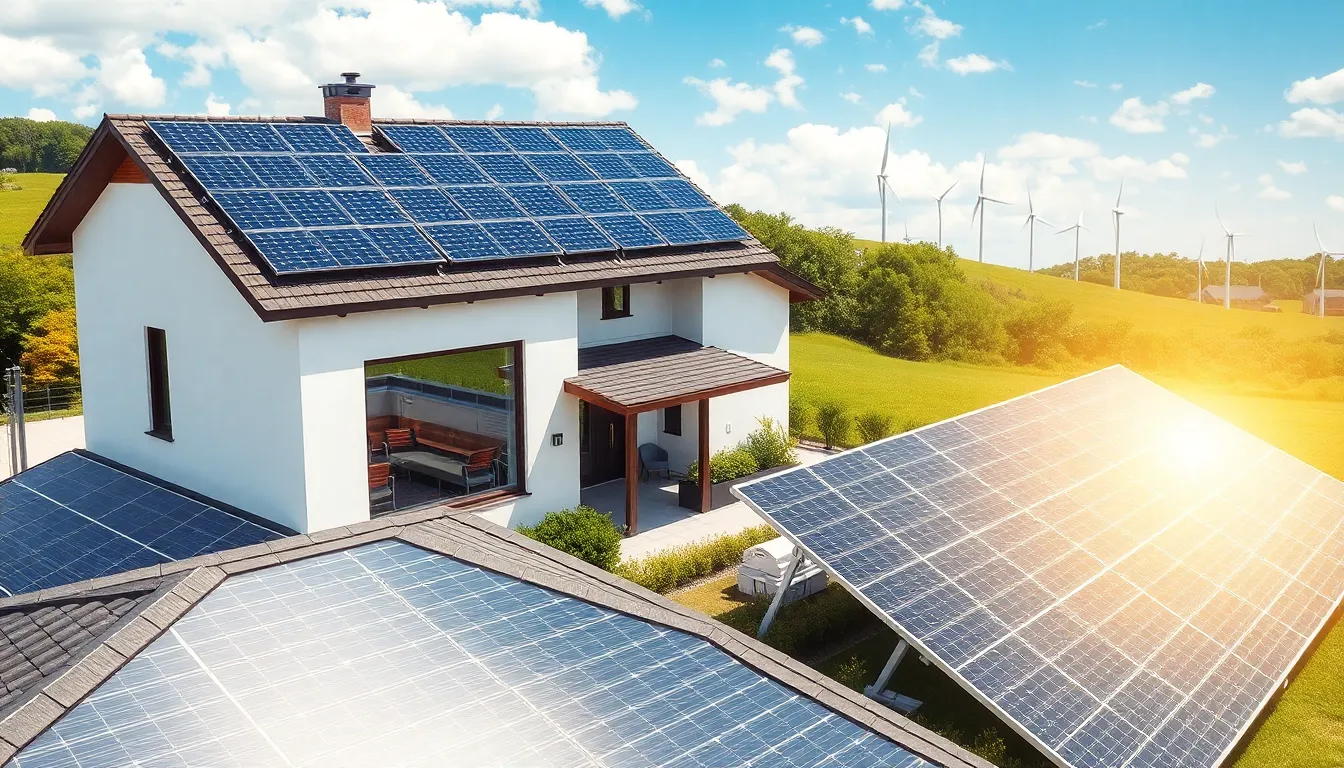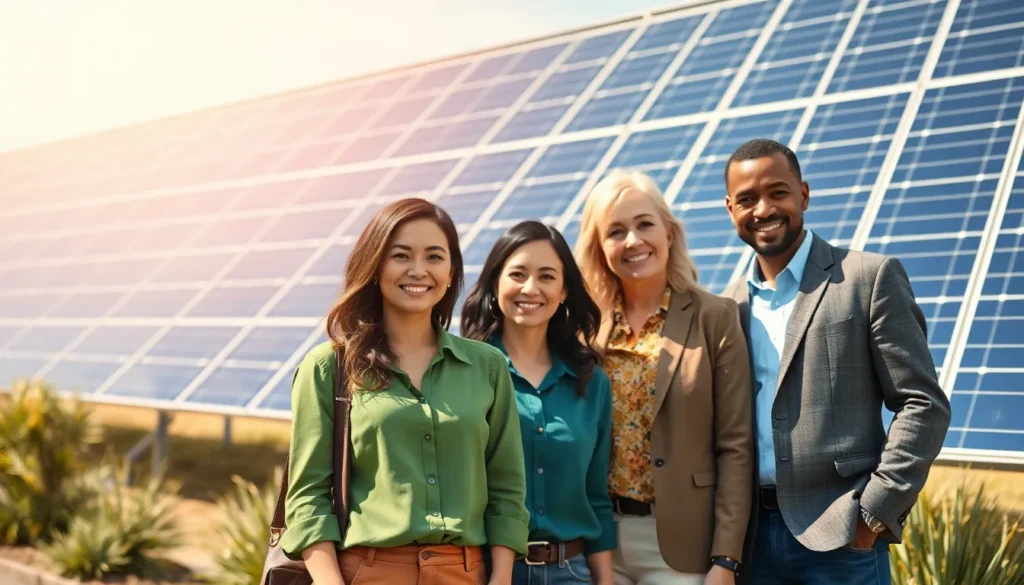In a world where climate change feels like that awkward family member who never leaves, green tech trends are stepping up to save the day. From solar panels that look like art to electric cars that make you feel like you’re in a sci-fi movie, the innovations in sustainable technology are not just impressive—they’re downright exciting.
Imagine a future where your gadgets not only power your life but also help save the planet. Sounds like a dream, right? Well, it’s happening now. As businesses and consumers embrace eco-friendly solutions, the green tech revolution is gaining momentum. Buckle up as we dive into the latest trends that are transforming our relationship with technology and the environment. Who knew saving the planet could be this cool?
Table of Contents
ToggleOverview of Green Tech Trends
Green technology trends showcase transformative innovations aimed at combating climate change. Renewable energy sources lead these advancements, with wind and solar energy experiencing significant growth. According to the International Renewable Energy Agency, solar power represented approximately 13% of global electricity generation in 2022, illustrating its rising importance.
Smart grid technology plays a crucial role in energy efficiency. These advanced systems enhance electricity distribution, allowing better integration of renewable sources and reducing carbon footprints. Companies increasingly adopt smart devices that optimize energy consumption in homes, resulting in lower utility bills.
Electric vehicles (EVs) are rapidly changing the transportation landscape. Sales of EVs surged by 55% in 2021, highlighting consumer interest in sustainable alternatives. Major automotive manufacturers invest heavily in EV technology, producing models that appeal to environmentally conscious consumers.
Sustainable building practices also gain traction within the green tech sphere. Leed-certified structures utilize eco-friendly materials and energy-efficient designs, directly impacting urban environments. By 2025, it’s anticipated that green building initiatives will contribute significantly to reducing global greenhouse gas emissions.
Circular economy principles attract attention among businesses and consumers alike. This approach focuses on minimizing waste through recycling and upcycling, promoting sustainable consumption patterns. Brands adopting circular strategies witness healthier profit margins while fostering environmental responsibility.
Emerging technologies, such as hydrogen fuel cells, offer promising prospects for decarbonizing various sectors. Interest in hydrogen solutions grows as they provide clean energy and support a shift to sustainable industrial practices. Organizations exploring hydrogen applications could transform logistics and transportation systems.
Investments in green technology are on the rise, underpinned by increased awareness of climate issues. Capital flowing into sustainable startups reached $61 billion in 2021, demonstrating a commitment to environmental progress. Stakeholders recognize the importance of aligning with eco-friendly solutions to address pressing challenges.
Renewable Energy Innovations

Innovations in renewable energy are shaping a sustainable future. Significant advancements in solar power and wind energy are leading this transformation.
Solar Power Developments
Solar power technology is evolving rapidly. Integrated solar roofs now blend aesthetics with functionality, appealing to homeowners. Bifacial solar panels increase energy capture by utilizing sunlight from both sides, enhancing efficiency. In 2022, concentrated solar power systems contributed to global electricity generation significantly. New materials, like perovskites, offer potential for lower production costs and increased performance. Analysts predict these developments may lead to widespread adoption within the next decade.
Wind Energy Advancements
Wind energy technology is also making remarkable strides. Turbine sizes continue to grow, with current offshore wind models reaching over 12 megawatts in capacity. This increase allows for substantial energy production from fewer installations. The innovations in turbine design, such as vertical-axis models, improve efficiency in varied wind conditions. Furthermore, advanced forecasting systems optimize energy generation by predicting wind patterns accurately. As of 2022, wind power accounted for around 10% of global electricity generation, reflecting its critical role in the energy transition.
Sustainable Transportation Solutions
Sustainable transportation solutions represent key innovations in the push towards greener lifestyles. Two major areas include electric vehicles and public transit improvements.
Electric Vehicles
Electric vehicles (EVs) play a crucial role in reducing carbon emissions. In 2021, EV sales surged by 55%, fueled by rising consumer demand and significant investments from automotive manufacturers. Major players in the market continue to innovate, developing new battery technologies to extend range and reduce charging time. Government incentives and infrastructure expansion support this trend, making EVs more accessible. Analysts project that by 2030, EVs could make up 30% of global vehicle sales, reshaping urban transportation landscapes.
Public Transit Improvements
Public transit systems are also undergoing significant enhancements. Cities increasingly invest in electric buses and trains, which minimize fuel consumption and lower emissions. Modernizing infrastructure improves efficiency, with real-time data systems aiding route optimization. Initiatives promote increased ridership by expanding service coverage, offering reliable and convenient options for commuters. This approach not only reduces traffic congestion but also fosters sustainable urban growth. With a focus on eco-friendly transit solutions, cities are set to transform public transportation into a cleaner, more efficient option for residents.
Smart Home Technologies
Smart home technologies are transforming living spaces into eco-friendly environments. These innovations minimize energy consumption while enhancing comfort and convenience.
Energy-Efficient Appliances
Energy-efficient appliances significantly contribute to reducing overall energy use in households. Refrigerators, washing machines, and dishwashers designed with high-efficiency ratings consume up to 50% less energy compared to standard models. Household devices often come equipped with smart features, allowing users to monitor energy consumption in real-time. By opting for ENERGY STAR-rated appliances, homeowners can lower their utility bills while reducing carbon footprints. Recent developments focus on integrating advanced technologies that optimize energy usage based on consumption patterns. Substituting older appliances with modern energy-efficient options leads to substantial long-term savings, supporting both personal finances and the environment.
Home Automation Systems
Home automation systems enhance energy savings and simplify daily routines. Smart thermostats adjust heating and cooling based on occupancy, maximizing comfort while minimizing waste. Lighting systems that utilize motion sensors and smart controls adapt to individual preferences and usage patterns. Additionally, users can manage appliances remotely, allowing for energy conservation when not at home. Integrating IoT devices into home environments improves overall energy efficiency, as connected systems facilitate real-time monitoring and automated adjustments. The growing popularity of energy management systems demonstrates the demand for smarter, more sustainable homes. This trend prioritizes both user convenience and environmental stewardship, aligning with the broader goals of green technology advancements.
Green Building Practices
Green building practices promote environmental sustainability and resource efficiency throughout a building’s life cycle, from design to construction and operation. These practices reduce environmental impact while enhancing the health and well-being of occupants.
Eco-Friendly Materials
Eco-friendly materials contribute significantly to sustainable construction. Recycled steel, for instance, minimizes waste and reduces carbon emissions when compared to traditional materials. Bamboo, known for its rapid regrowth, serves as a sustainable alternative for flooring and cabinetry. Additionally, low-VOC paints and finishes improve indoor air quality, benefiting residents. A focus on locally sourced materials supports regional economies while lowering transportation emissions, enabling a holistic approach to construction.
Sustainable Architecture
Sustainable architecture emphasizes energy efficiency and environmental integration. Passive solar design maximizes natural light, reducing reliance on artificial lighting. Green roofs, which provide insulation and absorb rainwater, contribute to urban biodiversity and energy savings. Buildings often incorporate advanced window technologies that enhance insulation while allowing ample sunlight. Water-efficient landscaping, utilizing drought-resistant plants, minimizes water usage while creating appealing outdoor spaces. Together, these elements foster a harmonious relationship between structures and their environments.
The shift towards green technology is not just a trend but a necessary evolution for a sustainable future. As innovations continue to emerge across various sectors, the integration of eco-friendly solutions becomes increasingly vital. From renewable energy advancements to smart home technologies, each development plays a crucial role in reducing environmental impact.
Investments in green tech reflect a growing commitment to combating climate change and promoting sustainability. As businesses and consumers embrace these changes, the momentum of the green tech revolution will likely accelerate, paving the way for a healthier planet. The future looks promising as technology aligns with environmental stewardship, creating a better world for generations to come.










